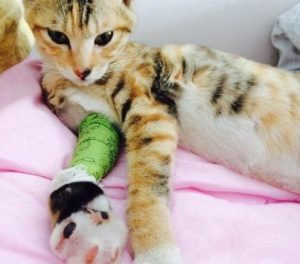Your cat leaps gracefully onto a bookshelf, embodying the agility that fascinates us—until a misjudged jump sends it tumbling. Despite their famed “righting reflex,” 1 in 5 cats experience fractures from falls under 6 feet, reveals a 2023 Journal of Feline Medicine study. This paradox—nimble climbers prone to skeletal trauma—stems from evolutionary instincts colliding with modern environments. Why do cats, evolutionarily designed for arboreal life, fracture bones in domestic settings? How does their behavior during injury impact recovery? This article decodes the science behind feline fractures, transforming panic into informed action when nine lives meet gravity’s limits.
Body
1. The Arboreal Legacy: How Climbing Hardwiring Increases Risk
Cats’ ancestors evolved to climb trees escaping predators, developing:
-
Lightweight bones: 30% less dense than dogs’
-
Flexible collarbones: Allows shoulder compression during falls
-
High pain tolerance: Mask injuries to avoid appearing vulnerable
Yet modern homes replace branch variability with slippery surfaces. Dr. Emily Sato, veterinary orthopedic surgeon, notes: *“A 4-foot fall onto tile poses greater fracture risk than a 15-foot tree descent onto leaf litter.”*
Case Study: A 2-year-old tabby named Mochi fractured her tibia jumping from a fridge onto linoleum—a scenario absent in wild felids.
2. Silent Suffering: Decoding Subtle Fracture Signs
Cats instinctively hide pain through:
-
Suppressed vocalization: Only 23% of fractured cats meow excessively (2024 UC Davis survey)
-
Altered grooming: Over-licking injury sites (releases endorphins)
-
Hidden lameness: “Bunny hopping” gait disguises single-leg injuries
Diagnostic Clues:
-
Warmth/swelling: Infrared thermography detects temperature spikes at fracture sites
-
Magnetic resonance imaging (MRI): Gold standard for hairline fractures
-
Weight distribution: Pressure-sensitive mats reveal <15% weight on injured limb
3. First-Aid Finesse: Why Improvising Harms
Common owner mistakes vs. vet-approved protocols:
| Mistake | Risk | Correct Action |
|---|---|---|
| DIY splinting | Nerve damage, compartment syndrome | Stabilize with rolled towel sled |
| Cleaning open fractures | Introducing pathogens | Cover with sterile saline gauze |
| Oral painkillers | NSAID toxicity (e.g., ibuprofen) | Vet-prescribed buprenorphine |
Pro Tip: Transport cats in carriers with removable tops to avoid jostling injuries.
4. Surgical Precision: Modern Repair Techniques
| Fracture Type | Treatment | Recovery Time | Cost Range |
|---|---|---|---|
| Greenstick | Rest + cage confinement | 3–4 weeks | 300–800 |
| Compound | External fixator | 8–12 weeks | 2,500–4,500 |
| Comminuted | Bone plate + screws | 12–16 weeks | 4,000–7,000 |
Breakthrough: 3D-printed titanium implants now customize bone repairs, reducing rejection rates by 40% (2024 Veterinary Orthopedics trial).
5. Behavioral Rehabilitation: Restoring Natural Instincts
Post-surgery care balances healing with mental health:
-
Enrichment: Food puzzles at ground level replace climbing
-
Pheromone therapy: Feliway® diffusers reduce stress-induced cortisol
-
Controlled remobilization: Underwater treadmills rebuild muscle safely
Case Study: A Persian cat regained full mobility after comminuted femur repair through weekly hydrotherapy sessions.
Q&A: Navigating Fracture Fallout
Q1: “Can cats fully recover from spinal fractures?”
A: 65% regain walking ability with methylprednisolone pulse therapy within 8 hours.
Q2: “Are bone supplements helpful pre-injury?”
A: Vitamin D3 (200 IU/day) and calcium citrate enhance bone density. Avoid excess—linked to urinary stones.
Q3: “How to cat-proof my home?”
A: Install textured window perches (3M Safety-Walk™ tape) and limit heights to 3 feet with carpeted steps.
Conclusion
Feline fractures are a collision course between evolutionary design and modern living—a test of our ability to honor cats’ climbing heritage while mitigating its risks. By decoding their pain signals and embracing advanced orthopedics, we transform accidents into opportunities for deeper interspecies understanding. Remember: Your cat’s leap toward the bookshelf isn’t recklessness; it’s a primal ode to wildness that deserves both celebration and safeguarding.

